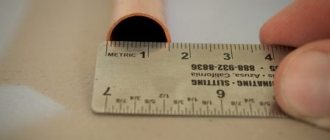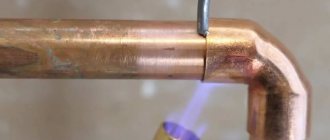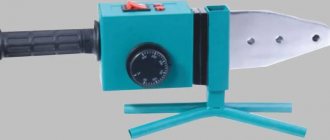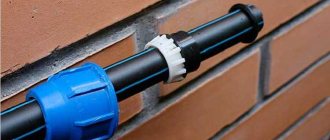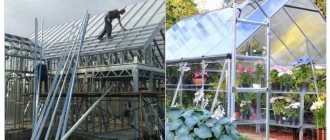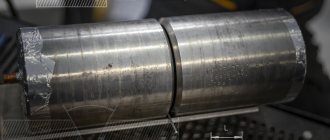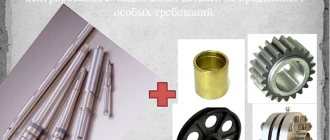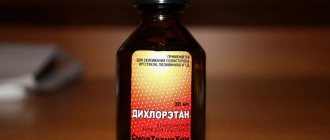Despite the frequent use of soldering technology for connections, copper pipe is often connected to fittings and fittings using mechanical methods without the use of heat from a gas torch. Moreover, with technological development, mechanical methods of connecting copper pipe assemblies are becoming more and more practical and rational for work. At the moment, connections of copper pipes, fittings and fittings can be made using several proven mechanical methods of detachable connections. Let us consider these options for mechanical assembly without heating in more detail.
Mechanical detachable connections for copper pipes
Plumbing and other practices are marked by the use of a number of methods for creating detachable connections, which are not inferior in reliability and strength to soldered ones. When operating plumbing and other systems where copper pipes are used, there are installation fragments where copper soldering is impossible in principle. For such situations, detachable mechanical connections are precisely applicable:
- Conical flaring.
- Rolling grooves.
- Bonding crimp.
- Insertion by pressing.
Let's consider the technological aspects of each method in case of use for the construction of copper pipeline systems.
Method #1: conical flare connection
Tubes deployed at the ends - widened towards the end - are considered an acceptable alternative for organizing a connection when the use of soldering is undesirable or impractical.
Water supply systems usually have a connection between a pipe and a socket when connecting, for example, a water flow meter. In addition, copper pipe often has to be connected to brass fittings by socket fitting the end parts of the pipes, flared to a cone at 45°.
A prepared conical mechanical connection of a copper pipe with a fitting for threaded fastening of the mating parts of the assembly. This method is widely used in the installation of air conditioning systems.
This kind of connection of a copper pipe with a fitting (fitting) is carried out using an appropriate tool, through which a conical flaring of the end part of the copper pipe is made. For each pipe size, a tool is used that matches the outside diameter of the copper pipe and the flaring angle—usually 45º.
The tool includes the following elements:
- sliding metal strips with holes of different diameters;
- a yoke equipped with a movable expanding cone;
- clamping screw for sliding bars.
The copper tube is pre-cut with a disk pipe cutter to obtain a smooth end at a right angle relative to the axis of the pipe. Then the nut of the brass fitting is put on the body of the copper pipe and the end part of the copper pipe is flared to the full internal diameter without any residual internal burrs.
Conical flaring (reaming) of the final part of a copper pipe using a special tool set for flaring copper pipes of different diameters
The flaring procedure is simple. Basic moments:
- align the end of the copper pipe exactly along the wide edge of the sliding rod;
- install the yoke along the control side holes exactly above the cut of the copper pipe;
- tighten the halves of the metal clamping strips with a fastening screw;
- Screw the yoke screw with the cone smoothly along the thread until a characteristic click is heard.
It should be noted that not all tools provide a sliding function when full flaring is achieved - they give a characteristic control “click”. Therefore, the flaring process should be additionally monitored.
Basic information
Copper fittings are connecting parts of a pipeline that can have different shapes and purposes. The main functions are connecting, spreading, turning the pipeline. The structure of fittings can differ greatly from each other. A simple example: threaded parts have threads at their ends, which are used for installation. Whereas the crimping parts can be in the form of a monolithic structure without threads at the ends.
Main types of parts depending on their shape:
- Straight connecting parts of constant diameter. They have the form of hollow cylinders, with the help of which two independent sections of the pipeline are connected. A characteristic feature is that the ends of the spare part have the same diameter. Therefore, such spare parts are put on pipes of the same diameter.
- Variable diameter straight connection parts. They also have the form of hollow cylinders for connection. The main feature is that the ends of the spare part have different diameters (example: 30 and 50 millimeters). Therefore, with the help of such parts, pipes that have different diameters are connected.
- Corner Copper Fittings. They look like two cylinders connected to each other at some angle. The angle size is usually 90 degrees, although obtuse and acute angle parts are found. Such spare parts are used if you need to connect several pipeline lines that intersect each other at an angle. They are also used to rotate the pipeline to solve structural problems (for example, a riser runs along the wall from the floor to the ceiling - after this it is turned).
- Adjustable parts. They have the form of parts that have three or more outlets (intersection parts with four adjustable holes are widely used). Such spare parts are used to divide the system into several independent pipelines, as well as to combine individual parts into a single system. In most cases, the exits are located at right angles, although there are also parts with oblique exits. If necessary, a plug can be installed on unused outputs, which can always be removed if necessary.
Method #2: Roll Groove connection
Pipelines created by connecting with end recesses (rolling grooves) have been practiced for a long time in the construction of sprinkler (irrigation) fire systems. Since 1925, this completely reliable method of connecting pipes has been used on steel and iron lines for heating, ventilation, air conditioning and other systems.
Meanwhile, a similar rolling groove mechanical joining method is also available for copper pipes with a diameter of 50mm to 200mm. The roll groove mechanical connection kit contains:
- couplings,
- gaskets,
- various fittings.
The roll groove mechanical joining system offers a practical alternative to soldering larger diameter copper pipes. Accordingly, the rolling groove method does not require additional heating (use of an open flame), as in the case of soldering with hard or soft solders.
The rolling groove at the end of the copper pipe is one of the main elements of the “rolling groove” connection method. Measuring after rolling determines the appropriate fitting
The connection using the rolling groove method is based on the ductility properties of copper and the increased strength of this metal during cold working. The design involves sealing the clamping system, for which a synthetic elastomer gasket (EPDM - Ethylene Propylene Diene Methylene) and a specially designed clamp are used. A number of manufacturers around the world offer tools for creating connections with rolling grooves - gaskets, clamps, fittings.
Fittings and work clamps with gaskets of various sizes are used in connection designs made using the rolling groove method.
Preparing and performing a rolling groove connection
As with other solderless copper joining processes, proper pipe end preparation is of primary importance to creating a strong, sealed joint. The correct choice of rolling groove connection tool for each type of copper pipe is also obvious. Manufacturer's recommendations must be followed to ensure safe, trouble-free preparation of these types of connections.
Table of permissible pressures and temperatures for this type of connection
| Connection type | Pressure range, kPa | Temperature range, ºC |
| Rolling groove, D = 50.8 – 203.2 mm, type K, L | 0 — 2065 | minus 35 / plus 120 for K minus 30 / plus 80 for L |
| Rolling groove, D = 50.8 – 101.2 mm, D = 50.8 – 203.2 mm type M | 0 — 1725 | minus 35 / plus 120 |
| 0 — 1375 | minus 30 / plus 80 |
Step-by-step process for assembling an assembly using rolling grooves:
- Cut the ends of the copper pipes to size exactly perpendicular to the axis.
- Remove burrs after cutting and chamfer.
- Roll grooves of the required dimensions, as required by the fitting manufacturer.
- Inspect fittings, gaskets, clamps for damage.
- Lubricate the gaskets according to the manufacturer's recommendations.
Before final assembly, inspect the clamping surfaces for cleanliness and the absence of construction debris. Assemble the connection in accordance with the manufacturer's recommendations.
An almost assembled fragment of the assembly using the “rolling groove” method. The elastic gaskets of the clamping bracket are treated with a small amount of lubricant before final seating of the copper pipes
The lug nuts should be finally tightened using the required torque in accordance with the manufacturer's recommendations. After tightening the screws, inspect the clamp area again to ensure that the assembly is assembled correctly.
Testing a Complete Rolled Groove System
Testing of a completed piping system can be carried out by applying air or water pressure to the system. The hydropneumatic method is also not excluded when a relatively high test pressure is used.
However, it should be taken into account that the test pressure value should not exceed the maximum permissible operating pressure specified by the manufacturer of the rolling groove system.
Consumables and tools
In addition to pipes and fittings, you will also need a torch, solder and flux for the soldering itself. And also a pipe bender and a few related little things to process before starting work.
Brush for cleaning fittings from the inside
Solder and flux
Soldering of copper pipes of any type occurs using flux and solder. Solder is an alloy usually based on tin with a certain melting point, but always lower than that of copper. It is fed into the soldering zone, heated to a liquid state and flows into the joint. After cooling, it provides a tight and durable connection.
For amateur soldering of copper pipes with your own hands, tin-based solders with the addition of silver, bismuth, antimony, and copper are suitable. Compositions with the addition of silver are considered the best, but they are the most expensive; the optimal ones are those with a copper additive. There are also ones with added lead, but they should not be used for plumbing. All these types of solder provide good seam quality and easy soldering.
Flux and solder - necessary consumables
Soft solder is sold in small spools, hard solder is sold in packs, cut into pieces.
Before soldering, the joint is treated with flux. Flux is a liquid or paste that allows molten solder to flow into a joint. There is nothing special to choose here: any flux for copper will do. Also, to apply the flux you will need a small brush. Better - with natural bristles.
Burner
To work with soft solder, you can buy a small hand torch with a disposable gas cylinder. These cylinders are attached to the handle and have a volume of 200 ml. Despite its miniature size, the flame temperature is 1100°C and higher, which is more than enough to melt soft solder.
What you should pay attention to is the presence of piezo ignition. This function is not superfluous - it will be easier to work with. There is a valve on the handle of the manual gas burner. It regulates the flame length (gas supply intensity). The same valve shuts off the gas if the burner needs to be extinguished. Safety is ensured by a non-return valve, which will shut off the gas supply if there is no flame.
Hand torch for soldering copper pipes
Some models have a flame deflector installed. It prevents the flame from dissipating, creating a higher temperature in the soldering area. Thanks to this, the burner with a reflector allows you to work in the most inconvenient places.
When working with household and semi-professional models, you must be careful not to overheat the unit so that the plastic does not melt. Therefore, it is not worth doing a lot of soldering at one time - it is better to let the equipment cool down and prepare the next connection at this time.
Related materials
To cut copper pipes, you need a pipe cutter or a hacksaw with a metal blade. The cut must be strictly vertical, which is ensured by a pipe cutter. And to ensure an even cut with a hacksaw, you can use a regular carpenter’s miter box.
Pipe cutter
When preparing pipes, they must be cleaned. There are special metal brushes and brushes for this (for cleaning the inner surface), but you can get by with sandpaper with medium and fine grain.
To remove burrs from cuts, there are chamfer removers. The pipe they used fits better into the fitting - its socket is only a fraction of a millimeter larger than the outer diameter. So the slightest deviations lead to difficulties. But, in principle, everything can be removed with sandpaper. It will just take more time.
It is also advisable to have safety glasses and gloves. Most home craftsmen neglect these safety measures, but burns are very unpleasant. These are all the materials and tools needed to solder copper pipes.
Method #3: Press-connect connection
Connecting copper pipe and copper alloy fittings using the crimp bonding method is fast, economical and does not require soldering technology. The Press-connect method originated in Europe in the late 1950s and is still used successfully today. Since the late 1990s, this connection method has spread throughout the world.
Structural view of a mechanical bonding crimp connection (“press-connect”), where high tightness is achieved through the use of an elastomer seal
The practice of using a bonding crimp connection shows satisfactory results. As in the previous (#2) option, the effect of plasticity and pronounced strength of copper during cold working is used here. The bonding crimp connection requires the presence of:
- special fitting,
- elastomeric gasket,
- crimping tool,
- special sponges.
Typical pressure and temperature ranges for bonded crimp connections are shown in the table below:
| Connection type | Pressure range, kPa | Temperature range, ºC |
| Crimp binder, D = 12.7 – 101.6 mm | 0 – 1375 | minus 18 / plus 120 |
| High pressure crimp binder, D = 6.35 – 31.75 mm | 0 — 4826 | Minus 32 / plus 150 |
Step-by-step creation of a bonding crimp connection
The copper pipe for the bonding crimp connection should be carefully inspected for dents, deep scratches, dirt, oil, grease, and other defects on the outside and inside. If a slight ovality of the copper pipe is detected in the crimp area, the defect must be corrected with an appropriate tool.
Step 1: adjusting the workpiece to size
Preparatory process before creating a unit using the “press-connect” method:
Accurately adjust the length of the copper pipe, taking into account the emphasis on the base of the bowl of the connecting unit. Cut the workpiece to size using a disc pipe cutter, keeping the end edge perpendicular. Remove burrs and chamfer the end part of the copper pipe to eliminate the possibility of damage to the gasket when inserting the copper pipe into the fitting.
Step 2: Mark insertion depth and select jaws
Selecting the appropriate cam mechanism and marking the depth of insertion of the end part during the application of the bond crimp method
fig8 Selecting the appropriate cam mechanism and marking the depth of insertion of the end part during the application of the bond crimp method
Check the fitting for use in the assembly, make sure that the sealing gasket is intact and is correctly positioned. The insertion depth of the copper pipe end into the fitting must be marked on the surface before inserting the copper pipe into the fitting. Select the appropriate size of pressing jaw and insert into the pressing tool.
Step 3: joining the copper pipe with the fitting and crimping process
Using a crimping tool at the final stage of creating a connection by mechanical pressing
The copper pipe should be inserted all the way inside the fitting, aligned until the pressing jaws are applied to the fitting. Place the clamping jaws on the fitting collar at a 90° angle (perpendicular) to the center line of the copper pipe. Activate the pressing tool trigger.
Upon completion of the pressing cycle, loosen the clamping jaws, remove the tool and visually inspect the seam, focusing on the previously placed mark on the surface of the copper pipe.
Step-by-step copper soldering technology
Soldering copper pipes begins with preparing the connection. The reliability of the connection depends on the quality of preparation, so devote enough time and effort to this process.
Soldering copper pipes consists of several stages
Preparing the connection
As has already been said, the cut of the pipe must be strictly vertical, without burrs, the pipe must not be wrinkled, the edge must be even and smooth. If there are even slight deviations, we take a bevel remover or sandpaper and bring the cut to perfection.
It is necessary to remove the oxidized layer
Next, take the fitting and insert the pipe into it. the part that goes into the socket requires cleaning. We take out the pipe and use sandpaper to remove the top oxidized layer from this part of the pipe. Then we carry out the same operation with the inner surface of the bell.
Flux application
Flux is applied to the entire cleaned surface - outside the pipe and inside the fitting. There are no difficulties here - the composition is evenly distributed with a brush.
Flux application
Soldering
The treated pipeline fragments are inserted into one another and fixed. If there is an assistant, he can hold the parts motionless. If not, you'll have to figure it out yourself. Next, the burner is ignited and the flame is directed to the connection point. The flame temperature is from a thousand degrees and above, and the joint must be heated to 250-300°C, and this takes 15-25 seconds. In this case, you can focus on the color of the flux - as soon as it darkens, it’s time to introduce solder.
Correct position of the torch when soldering copper pipes with your own hands
To ensure uniform heating, direct the burner flame in the middle of the joint. Then the entire welding zone heats up more evenly.
Soldering copper pipes with soft solder
Solder is injected into the joint - where the fitting and pipe connect. As it heats up, it begins to melt, spreads and fills the gap between the elements. You can only apply it to half the length - once it melts, it will flow into the rest of the joint. Actually, that's all - the soldering of the copper pipes is finished. All other connections are made the same way.
When using hard solder, everything is almost the same, only other burners are used - gas-flame ones, and during the soldering process you need to turn the pipe, winding the softened solder onto the pipe.
High pressure crimp connections
Advances in bonded crimp technology and the development of O-ring materials are allowing bonded crimp connections to be used for high pressure applications. However, high pressure systems require a slightly different jaw configuration.
The result of manufacturing a connecting unit using the 360º double crimping technique
Bonded crimp connections for low pressure piping, process piping and non-medical compressed gas lines use a single standard hexagonal pressing shape.
Higher pressure bonding crimp connections require the use of specially designed press fittings and clamping jaws to provide a 360° double crimp on the fitting.
